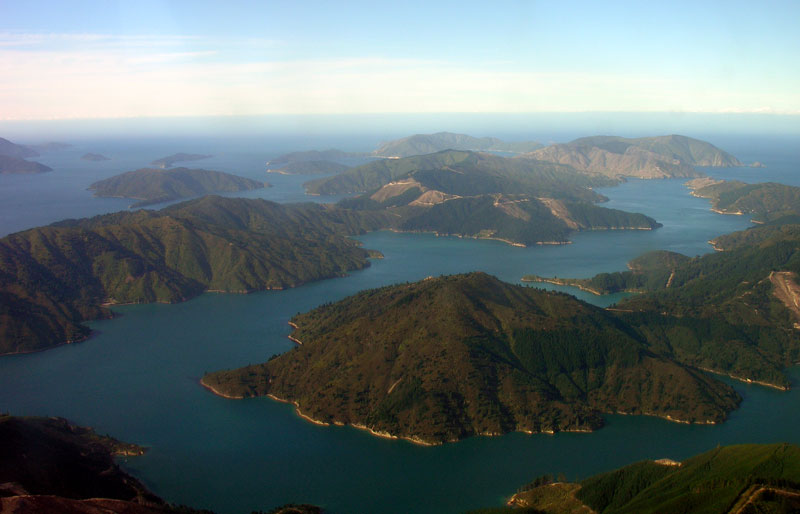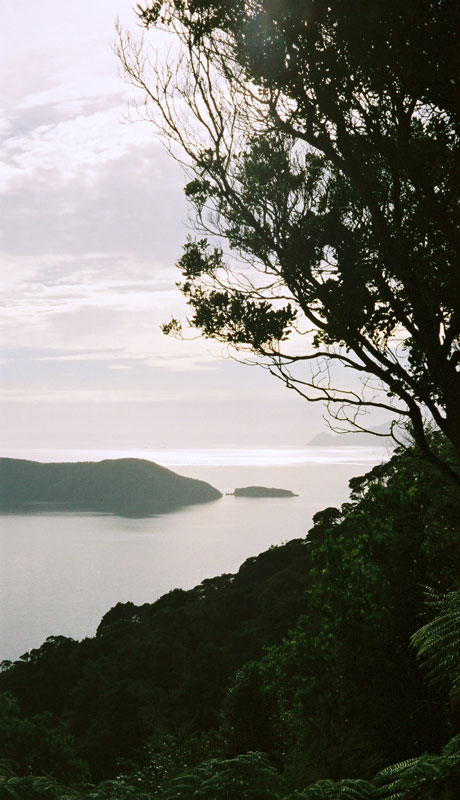Queen Charlotte Track
Country: New Zealand by Lisette
24-02-2005
I arrived in Picton with the ferry from Wellington. As I entered the Marlborough Sounds I almost couldn’t believe my eyes. This area is like a paradise! The Marlborough Sounds are made of “ sea-drowned valleys ” , partial submergences of un-glaciated river valleys, at the northeast of the South Island. The area has many islands and peninsulas.
 Queen Charlotte Sound (Photo by PhilipC, Flickr)
Queen Charlotte Sound (Photo by PhilipC, Flickr)
These quiet bays are sparsely populated because access is often only by boat. The main large port is Picton on the mainland. It is a cute little town that lives quietly and modestly. It was easy to find my hostel in a 100-year old traditional guesthouse.
To my surprise the local hairdresser also acted as the lingerie sales person. Then I realized the grocery store also had a hardware section. At ease and content I sauntered around and after I bought a newspaper, I read it from a to z while sipping a tea on a sunlit terrace.
History of “The Sounds”
The area was well known and traveled by Māori people for the abundance of food and shelter it had to offer. Māori mythology says the sounds are the prow of the sunken waka (canoe) of Aoraki. Aoraki, named by the first Europeans to show up here Mount Cook, is the highest mountain of the country and is part of the Southern Alps.
Aoraki was a son of Rakinui, Sky Father. As he and his brothers traveled around Papatuanuku (Earth Mother) their canoe stranded on a reef. He and his brothers climbed on the topside of their canoe to survive. The south wind froze them and turned them to stone, essentially the South Island. Aoraki was the tallest of his siblings and became the highest peak.
To this day, Aoraki plays an important role for Māori, especially for the main tribe (iwi) Ngāi Tahu of the South Island. The tribe considers Aoraki as the most sacred ancestor they descend from and cherish the link between the natural and supernatural world.
Europeans came to the Marlborough Sounds’ area in the 1770s. On one of the islands, Motuara Island, Captain Cook claimed the land for the British government. However, the area never became densely populated.
Hiking the Queen Charlotte Track
The Queen Charlotte Sounds is the most visited and is the “drowned valley” I saw as I came to Picton with the Wellington Ferry. At the end of the Sound is Ship Cove where I started hiking part of the Queen Charlotte Track the next day. This track is 71 kilometres long and goes through forest, along coastlines and follows the ridge.
I decided to walk the first 28 kilometres of the track in one day, starting at Ship Cove. Apparently, Captain Cook stopped here five times in the late 1700s. A lookout offers a good view of Motuara Island . From there on you climb a little and descend into Resolution Bay.
The paths may be old, but all well maintained and well marked. I found myself surrounded in an old forest with kamahi, beech, ferns, manuka, and kanuka with a wide range of bird species inhabiting the trees.
I was concerned the distance would be too long or the walk to challenging (steep for example), but it was fine. Soon I was walking with an English man, Daniel, and a German girl, Katharina. It’s very nice to walk together and have someone to talk to.
The crazy beautiful views were worth every hill I had to walk to reach it! After walking for 7,5 hours (including resting time) I was early for my boat going back to Picton. I had worried so much about being late and getting stranded that I had constantly pushed myself. And so I felt I deserved a lovely wine before heading back to the mainland.





Profile